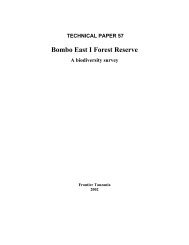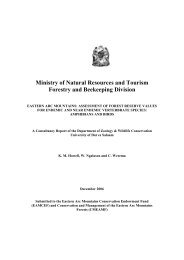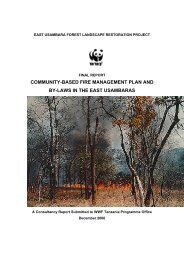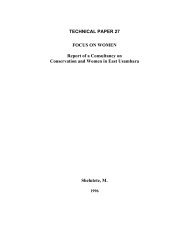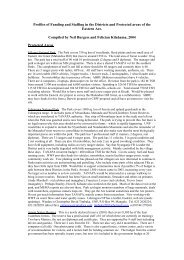Butterfly Farming in the East Usambara Mountains - Eastern Arc ...
Butterfly Farming in the East Usambara Mountains - Eastern Arc ...
Butterfly Farming in the East Usambara Mountains - Eastern Arc ...
You also want an ePaper? Increase the reach of your titles
YUMPU automatically turns print PDFs into web optimized ePapers that Google loves.
very common. It occurs from 300 meters to 900 meters but is most common around 400<br />
to 600 meters. It can be trapped with ferment<strong>in</strong>g bananas.<br />
• Hamanumida daedalus – Common year round <strong>in</strong> disturbed areas. Flies very low along<br />
ground. Host plant not yet identified. Related to Euphaedra, so possible problems with<br />
humidity changes <strong>in</strong> shipp<strong>in</strong>g. Adults are attracted to ferment<strong>in</strong>g fruit.<br />
• Hypolimnas antevorta – Endemic to <strong>the</strong> <strong>East</strong> <strong>Usambara</strong> Mounta<strong>in</strong>s. Some unconfirmed<br />
reports from <strong>the</strong> West <strong>Usambara</strong> Mounta<strong>in</strong>s. Though it is seen every month of <strong>the</strong> year, it<br />
is most prevalent <strong>in</strong> August, September, and October at altitudes between 800 and 300<br />
meters. Adults feed on mango. It is easily bread on Urera species.<br />
• Hypolimnas an<strong>the</strong>don – This species is common year round along rivers and roads from<br />
900 meters to 300 meters and is an excellent mimic of Amauris niavius and Amauris<br />
albimaculata. Females will only lay eggs on <strong>the</strong> common Laportia species found <strong>in</strong> rocky<br />
areas. However, large larvae will migrate to any species of Urera once <strong>the</strong>y have f<strong>in</strong>ished<br />
<strong>the</strong>ir Laportia food plant. Adults will feed on mango.<br />
• Hypolimnas misippus – This species is very common <strong>in</strong> Amani at 800-900 meters <strong>in</strong> open<br />
areas dur<strong>in</strong>g <strong>the</strong> months of January, February, and March. It is likely available at lower<br />
elevations at o<strong>the</strong>r times of <strong>the</strong> year. It uses a species of Justica that grows <strong>in</strong> open,<br />
grassy areas.<br />
• Hypolimnas usambara – This gigantic species is very reclusive and as a result rarely seen<br />
<strong>in</strong> Amani. It may be more common <strong>in</strong> <strong>the</strong> Kambai Forest Reserve. It specializes on Urera<br />
sansibarica grow<strong>in</strong>g off of rocky cliffs or boulders, preferr<strong>in</strong>g to lay eggs at <strong>the</strong> ends of<br />
<strong>the</strong> grow<strong>in</strong>g tips. It has been seen from 500 meters to 800 meters, usually <strong>in</strong> dense forest.<br />
Adults likely feed on ferment<strong>in</strong>g fruit.<br />
• Junonia oenone – This species is common <strong>in</strong> Amani dur<strong>in</strong>g <strong>the</strong> dryer months, though<br />
some can be seen year round <strong>in</strong> open grassy areas. It most likely uses a species of Justica<br />
or Asystasia, but no plant has been located yet. Found at all elevations <strong>in</strong> Amani. The<br />
pupa phase is likely very short at around 5 or 6 days.<br />
• Junonia terea – This species is more of a forest edge species than oenone. It is common<br />
<strong>in</strong> Amani year round from 600 meters and up and lays on Justica and Asystasia grow<strong>in</strong>g<br />
along <strong>the</strong> forest edge. The specific plant has not been located. The pupa phase is also<br />
likely short at 5 or 6 days.<br />
• Precis octavia – This species is small but seems to have sufficiently long pupae phase for<br />
shipp<strong>in</strong>g. It breeds on Katange (Kiswahili) a houseplant with green and maroon leaves<br />
that must be <strong>in</strong> <strong>the</strong> Lamiaceae family. Females also lay eggs on wild members of this<br />
family, but not as frequently. I have not worked out its seasonality but it seems to be<br />
found <strong>in</strong> <strong>the</strong> Amani area at all elevations <strong>in</strong> low numbers year round. Adults <strong>in</strong> captivity<br />
will feed on mango.<br />
11



